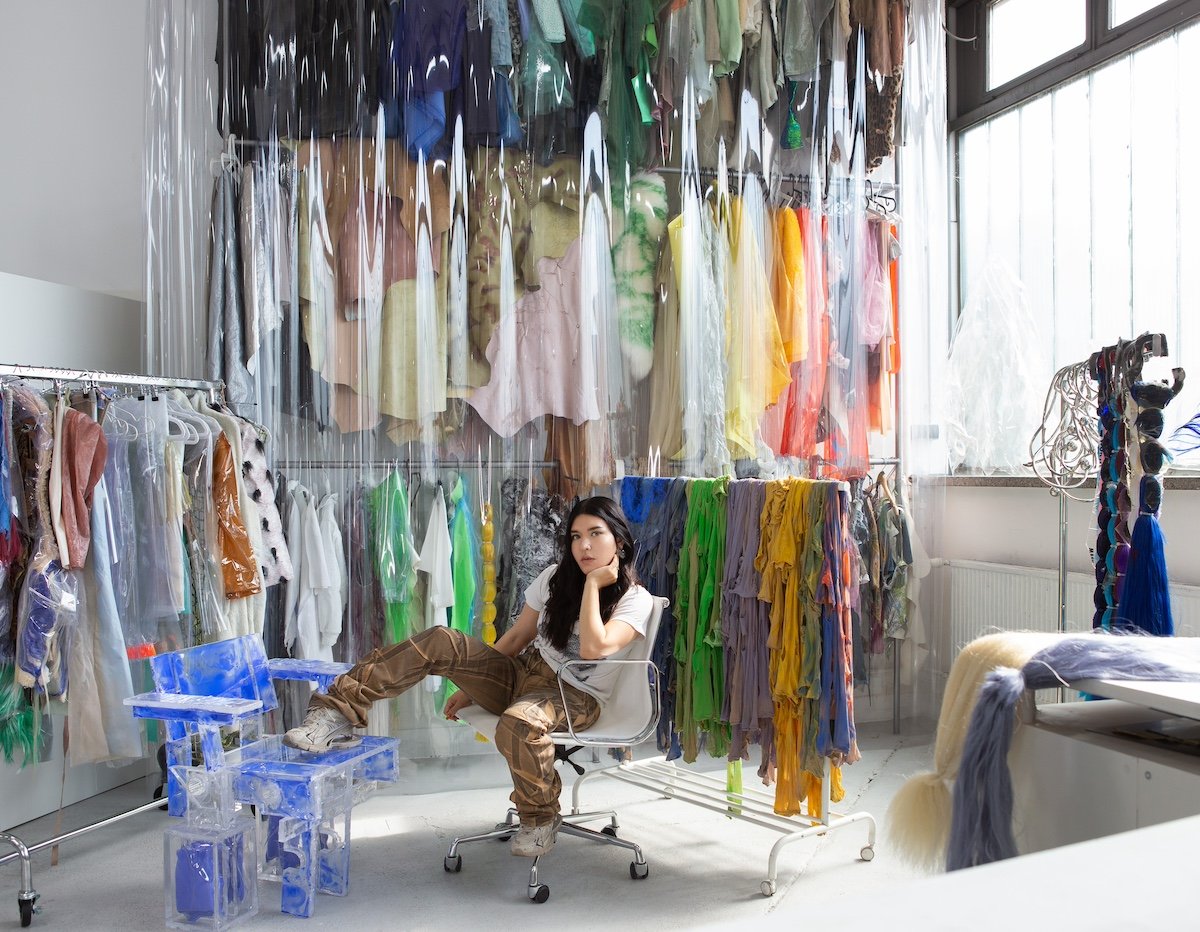
The most profound encounter with an artwork that Donna Huanca has ever experienced was not with an artwork at all—at least not technically. It was with the Festival de Urkupiña, a days-long celebration in Cochabamba, Bolivia, that honors the mythic, 17th-century moment when the Virgin Mary revealed herself to a poor shepherdess in the nearby hills of Quillacollo.
According to lore, Mary instructed the young woman to collect stones from the Earth and return them to her home. When the shepherd complied, the stones she had gathered transmutated into silver. Her family members were rescued from poverty, but when they trekked up the hill to see the Virgin Mother for themselves, they found only a stone image of her likeness.
Installation view of “Donna Huanca: VENAS DEL CAPULLO” at Sean Kelly, New York, November 9 – December 23, 2023. Photo: Jason Wyche. Courtesy of the artist and Sean Kelly.
Huanca, a Bolivian-American born in Chicago, first visited the festival with her family as an eight-year-old. There, she bore witness to its long-established traditions: a roisterous kick-off parade, a Catholic mass, and a public procession wherein locals carry their own rocks up the famous hill.
“This was my first experience of a total work of art,” the 43-year-old artist said, speaking on the occasion of two recently-opened exhibitions in New York: “VENAS DEL CAPULLO” at Sean Kelly, and “SCAR TISSUE (BLURRED EARTH)” at Faurschou New York. “The visual and sonic overload of the festival exposed me to the power of sound, color, couture, and ritual. I remember the chaos and noise of this experience to be enthralling and healing. It gave me access to higher realms of experience beyond this reality.”
A painted performer interacting with Huanca’s work in “SCAR TISSUE (BLURRED EARTH)” at Farschou New York, 2023. Photo: Victoria Hely Hutchinson.
That Huanca would find inspiration in the festival’s rich cultural history and sense of spiritual communion makes sense: it’s from these same base themes that her work is alchemized. The influence is never more apparent than in the artist’s frequent performances, for which she paints the semi-nude bodies of (mostly queer and trans) models, then invites them to interact with her sculptures and canvases in the gallery. It’s performance art, but it looks more like liturgy.
Site-specific installations make up both of Huanca’s current New York shows, each filled with kaleidoscopic paintings and pierced, mirrored sculptures that play perspectival tricks as you navigate them. These objects are, in the strictest sense, inanimate. Or so they seem: to come to that conclusion, Huanca pointed out, is to consider them only in the moment of encounter. Would you assume a person can’t walk just because you find them asleep?
Installation view of “Donna Huanca: SCAR TISSUE (BLURRED EARTH)” at Farschou New York, October 21, 2023 – July 14, 2024. Photo: Thomas Mueller. Courtesy of the artist, Peres Projects, and Farschou New York.
Huanca’s artworks may be still, but they’re never static. They are, for her, akin to complex organisms: constantly growing, changing. You can see it in their surfaces, which evolve over the course of a show—or several—as the marks of the artist and her body-painted performers accumulate. Just as the shepherdess’s stones turned into silver at the bottom of the hill, Huanca’s work rarely looks the same coming down as when it went up.
“To me, [the artworks] are very alive,” she said. “The reflective metal sculptures are shapeshifters that collect, refract and react to the information surrounding them. Sound and scent circulate throughout the installations, activating a movement within it as well.”
Photo: Victoria Hely Hutchinson.
Huanca’s Sean Kelly presentation is enveloped in a sheet of semi-translucent plastic, effectively turning the gallery into what she called a “womb space that functions like a petri dish in which primal sensory signals proliferate.” The Faurschou show, meanwhile, “unfolds as a labyrinth open to exploration, where viewers encounter geological relics, ladders, and maps,” she said. “Reminiscent of a gathering of shapeshifters, the sculptures function as active surrogates for the performers.”
In both shows are faint traces of the Festival de Urkupiña, Huanca explained. “The fact that I have always navigated between mediums, creating immersive environments that engage all the senses, certainly originates… from that initial aesthetic experience. My installations are meant as places of connectivity. They are infused with ideas of community building and trust that are also inherent to the festival and its experience.”
More Trending Stories:
Art Dealers Christina and Emmanuel Di Donna on Their Special Holiday Rituals
Stefanie Heinze Paints Richly Ambiguous Worlds. Collectors Are Obsessed
Inspector Schachter Uncovers Allegations Regarding the Latest Art World Scandal—And It’s a Doozy
Archaeologists Call Foul on the Purported Discovery of a 27,000-Year-Old Pyramid
The Sprawling Legal Dispute Between Yves Bouvier and Dmitry Rybolovlev Is Finally Over